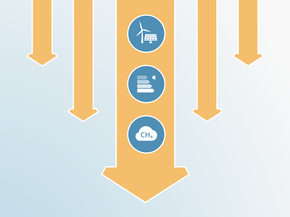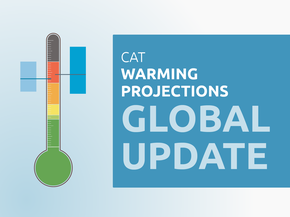Targets
Target overview
In its NDC, Peru sets an unconditional target to not exceed an emissions level of 208.8 MtCO2e in 2030. This target covers all sectors and is reported using Global Warming Potential (GWP) values from the IPCC's Second Assessment Report (SAR). The CAT excluded emissions from land use, land use change and forestry (LULUCF) from this target and converted it to IPCC Fifth Assessment Report (AR5) GWP values (see the Assumptions section for more details), resulting in a 2030 target of up to 129.4 MtCO2e in 2030.
The CAT rates this target as “Almost sufficient” compared to Peru’s fair share. This rating has changed compared to our previous assessments (rated “Insufficient”) due to a literature update to our fair share (FS) ranges, which aligns our equity approaches with international environmental law (Rajamani et al.) and therefore exclude studies based on cost-effectiveness; we also included additional studies to reflect the latest research available in the field. Therefore, this change in rating does not represent improved climate action, compared to previous assessments.
The NDC also includes a conditional target to limit emissions to 179.0 MtCO2e by 2030. Once again, the CAT excluded LULUCF emissions from the target and converted the SAR GWP values to AR5, resulting in a target of 113.6 MtCO2e by 2030. This represents around 15 MtCO2e reduction below the unconditional target (excl. LULUCF). The CAT rates this target as “Insufficient” when compared to what is needed to happen domestically, with international support (modelled domestic pathways).
Peru’s NDC states an intention to reach net zero emissions by 2050 and Peru’s net zero target was clarified and expanded in Peru’s framework long-term policy document, the “Estrategia Nacional ante Cambio Climático al 2050” (National Strategy on Climate Change to 2050; ENCC). The ENCC was submitted to the UNFCCC as Peru’s official Long-Term Strategy in June 2025.
| PERU — Main climate targets |
|---|
| 2030 unconditional NDC target | |||
|---|---|---|---|
| Formulation of target in NDC | Peru’s national contributions set an unconditional goal of limiting its GHG emissions to a maximum level of 208.8 MtCO2e by 2030 | ||
|
Absolute emissions level in 2030 excl. LULUCF |
129.4 MtCO2e [39% above 2010] |
||
| Status | Submitted on 18 December 2020 | ||
| 2030 conditional NDC target | |||
|---|---|---|---|
| Formulation of target in NDC | Conditioned to the availability of international financing, Peru proposes to limit its GHG emissions to a level of 179 MtCO2e by 2030 | ||
|
Absolute emissions level in 2030 excl. LULUCF |
113.6 MtCO2e [22% above 2010] |
||
| Status | Submitted on 18 December 2020 | ||
| Net zero & other long-term targets | |||
|---|---|---|---|
| Formulation of target | Peru aims to reach net zero emissions by 2050 | ||
|
Absolute emissions level in 2050 excl. LULUCF |
86 MtCO2e [6% below 2010] |
||
| Status | Announced the intention in its updated NDC, submitted on 18 December 2020. Codified in December 2024 | ||
NDC updates
2030 NDC targets
| PERU — History of 2030 NDC updates | First NDC (2016) | 2020 NDC update |
|---|---|---|
| 1.5°C compatible |
|
|
| Stronger target | N/A |
|
| Fixed/absolute target |
|
|
Summary and analysis of the target
On December 18, 2020, Peru submitted an updated NDC to the UNFCCC that represents progress beyond its previous submission but that is still incompatible with limiting global warming to the Paris Agreement’s 1.5°C limit. The regulation of the framework law on climate change (approved at the end of 2019), makes Peru’s Paris Agreement pledge legally binding (SINIA, 2020).
With its target, Peru commits to limiting emissions to about 129.4 MtCO2e (excl. LULUCF) by 2030, according to our calculations. This is an improvement compared to its first submission in two ways: it leads to a lower emissions level by 2030 and it has changed its format from a reduction below BAU to an absolute emissions reduction target.
Peru’s submission also includes a conditional 2030 target which, according to our calculations, limits emissions to about 113.6 MtCO2e (excl. LULUCF) by 2030, conditional to access to international climate finance (Gobierno del Perú, 2020a). This represents a step forward compared to the first submission by leading to a lower emissions level by 2030 and strengthening the target’s format to an absolute emissions reduction target. No further details have been provided for the conditional target (e.g., sectoral contributions to the target), making it difficult to assess.
This NDC is less transparent as it provides fewer details than its predecessor in terms of the expected emissions reduction contribution from each sector and, more importantly, from the LULUCF sector (Gobierno del Perú, 2020a). In general, Peru should avoid relying on LULUCF sinks to achieve its climate targets as much as possible, given the high chance of carbon loss through deforestation or natural disturbance and eventual competition for land.
Additionally, as stated in the NDC, Peru updated the ENCC with a timeframe up to 2050. The ENCC is a multi-sectoral policy document that translates Peru’s legal obligations under the Kyoto Protocol and Paris Agreement into a domestic policy agenda. The updated ENCC was approved by the government in November 2024 (MINAM, 2022, 2025).
| PERU | First NDC | 2020 NDC update |
|---|---|---|
| Formulation of target in NDC |
Unconditional target: The Peruvian government considers the implementation of a 20% reduction in GHG emissions through investments and expenditures with internal, public and private resources. Conditional target: The Peruvian NDC targets a 30% reduction in GHG emissions projected for the year 2030, under a Business as Usual (BAU) scenario. |
Unconditional target: Peru’s national contributions set an unconditional goal of limiting GHG emissions to a maximum level of 208.8 MtCO2e Conditional target: Conditioned to the availability of international financing, Peru proposes to limit emissions to 179 MtCO2e |
|
Absolute emissions level [excl. LULUCF] |
Unconditional target: 131 MtCO2e by 2030 (in AR4) Conditional target: 116 MtCO2e by 2030 (in AR4) |
Unconditional target: 129 MtCO2e by 2030 (in AR5) Conditional target: 114 MtCO2e by 2030 (in AR5) |
|
Emissions compared to 1990 and 2010 [excl. LULUCF] |
Unconditional target: 145% above 1990 emissions by 2030 53% above 2010 emissions by 2030 Conditional target: 117% above 1990 emissions by 2030 35% above 2010 emissions by 2030 |
Unconditional target: 39% above 2010 emissions by 2030 Conditional target: 22% above 2010 emissions by 2030 |
| CAT rating |
Overall rating*: Insufficient |
Unconditional target against fair share: Almost sufficient** Conditional target against modelled domestic pathways: Insufficient |
| Sector coverage | Economy-wide | Economy-wide |
| Separate target for LULUCF | No | No |
| Gas coverage | CO2, CH4, N2O | CO2, CH4, N2O, HFCs, PFCs, SF6 |
| Target type | Emissions reduction from BAU | Absolute emissions reduction (single year target, or from a base year) |
* Before September 2021, all CAT ratings were based exclusively on fair share and only assessed a country’s target.
** This change in rating is due to a literature update to our fair share (FS) ranges, which aligns our equity approaches with international environmental law (Rajamani et al.) and therefore exclude studies based on cost-effectiveness; we also included additional studies to reflect the latest research available in the field. Therefore, this does not represent improved climate ambition, compared to previous assessments.
Note: As of 2025, all CAT calculations are using global warming potentials of the IPCC’s 5th assessment report (AR5).
Target development timeline & previous CAT analysis
CAT rating of targets
The CAT rates NDC targets against what a fair contribution to achieving the Paris Agreement’s long-term temperature goal would be, as well as against what needs to happen within a country’s own borders. Peru will need international support to achieve those needed reductions within its borders.
Peru has put forward two targets in its NDC: one that it will achieve using its own resources (unconditional target), and one that requires international support (conditional target). For the rating, we compare the unconditional target to Peru’s fair share contribution and its conditional target to Peru’s modelled domestic pathways.
We rate Peru’s conditional NDC target as “Insufficient” when compared with modelled domestic pathways. The “Insufficient” rating indicates that Peru’s conditional target in 2030 needs substantial improvements to be consistent with modelled domestic pathways needed to limit warming to 1.5°C. If all countries were to follow Peru’s approach, warming would reach over 2°C and up to 3°C.
We rate Peru’s unconditional target as “Almost sufficient” when compared with its fair-share contribution to limit warming to 1.5°C. This change in rating compared to our previous updates is due to a literature update to our fair share (FS) ranges, which aligns our equity approaches with international environmental law (Rajamani et al.) and therefore exclude studies based on cost-effectiveness; we also included additional studies to reflect the latest research available in the field. Therefore, this does not represent improved climate ambition, compared to previous assessments.
Our analysis shows that Peru could reach its unconditional NDC target under current policies, without the need for additional, more ambitious policies. Peru’s unconditional NDC target is not 1.5°C compatible – this is a missed opportunity for Peru to enact ambitious emissions reductions in line with the Paris Agreement’s 1.5°C temperature limit.
The recent advisory opinion on climate change issued by the International Court of Justice (ICJ) reaffirmed the scientific consensus that the 1.5°C limit is the fundamental goal of the Paris agreement and reinforces the responsibility of states to issue 1.5°C compatible NDC targets. Peru’s 2035 NDC, expected this year, presents a key opportunity to not only establish an ambitious, 1.5°C compatible 2035 target, but to also revise the 2030 target to be in alignment with the Paris Agreement.
Further information on how the CAT rates countries (against modelled domestic pathways and fair share) can be found here.
Net zero and other long-term target(s)
We rate the net zero target as: Average.
Peru committed to a net zero emissions target by 2050, approved via a declaration from the Ministry of the Environment (MINAM) in November 2024 (MINAM, 2024). According to our calculations, this target will lead to 86 MtCO2e in 2050 (excl. LULUCF, see assumptions section for details), or roughly 6% below 2010 levels. As Peru’s net zero target does not include a separate reduction target for the LULUCF sector, the CAT estimates the target value (see Assumptions). A separate target for the LULUCF sector would strengthen the transparency and analytical rigor of Peru’s net zero target.
In November 2024 Peru updated its Climate Change National Strategy (ENCC) with a timeframe up to 2050. The ENCC is the key policy document behind the net zero target (MINAM, 2025). This update was based on a Technical Study from the Inter-American Development Bank, commissioned by MINAM to explore pathways to reach carbon neutrality by 2050 (Quirós-Tortos et al., 2021).
The study notes that "carbon neutrality" is understood to cover all GHGs and will be achieved through a combination of domestic emissions reduction and increasing domestic carbon sinks. Alongside the technical study, the ENCC takes into account a series of consultations with key stakeholder groups to develop priority objectives including (among others):
- Reducing climate risk to vulnerable populations
- Mitigating GHG emissions from energy, transport, agriculture and LULUCF
- Improving climate change governance in state and non-state actors.
This is a step in the right direction: transitioning to a low-emissions development pathway in compliance with international climate change commitments. In order to meet its target, Peru must move swiftly to implement the ENCC and associated policies.
Current policy projections are only marginally aligned with the least ambitious end of Peru’s 2030 target and are not aligned with a long term low-emissions development pathway without decisive intervention. At the same time, Peru should avoid relying on LULUCF sinks to achieve its net zero target, given the high chance of carbon being released back into the atmosphere through deforestation or natural disturbance and eventual competition for land.
In June 2025, Peru submitted the ENCC as its official long-term strategy to the UNFCCC.
For the full analysis click here.
Further analysis
Latest publications
Stay informed
Subscribe to our newsletter




